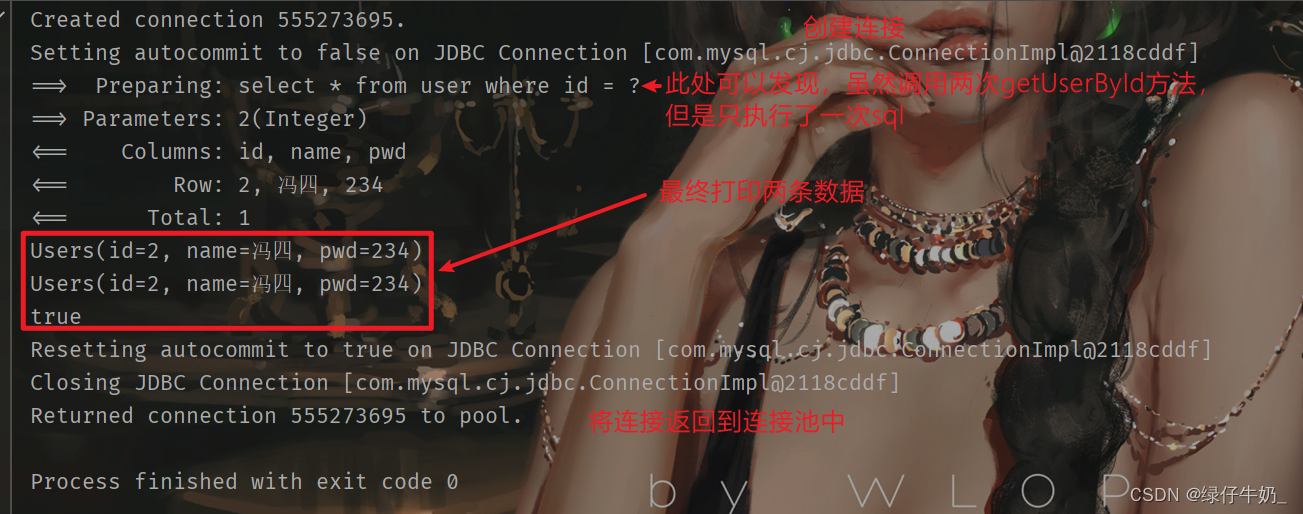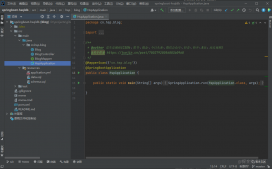动态SQL
为什么叫做动态SQL:因为在程序执行中,mybatis提供的sql可以根据用户提供的字段数量、类型,合理的选择对应的执行sql。正是这一动态的选择特性,极大的优化了使用JDBC的代码冗余。
根据不同条件生成不同的sql语句执行
环境准备
以博客表为例:
|
1
2
3
4
5
6
7
|
create table `blog`( `id` varchar(50) primary key comment '博客ID', `title` varchar(100) not null comment '博客标题', `author` varchar(50) not null comment '博客作者', `create_time` datetime not null comment '创建时间', `view` int not null comment '浏览量'); |
Blog实体:
|
1
2
3
4
5
6
7
8
9
|
@Data@AllArgsConstructorpublic class Blog { private String id; private String title; private String author; private Date creatTime; private int views;} |
IDutils,用于随机生成的ID名称
|
1
2
3
|
public static String getId(){ return UUID.randomUUID().toString().replaceAll("-","");} |
IF语句
以上述搭建的环境为例,当我们需要查询博客时,如果用户指定了搜索搜索字段那就根据该字段查找,如果没有指定那就查询全部。如果用普通的sql语句实现,需要我们在Java程序中进行判断,但是MyBatis提供了动态SQL,我们就可以利用内置的IF标签来实现:
BlogMapper.xml配置
|
1
2
3
4
5
6
7
8
9
|
<select id="getBlogListIF" parameterType="map" resultType="Blog"> select * from blog where 1 = 1 <if test="title != null"> and title like "%"#{title}"%" </if> <if test="author != null"> and author like "%"#{author}"%" </if></select> |
测试:
|
1
2
3
4
5
6
7
8
9
10
11
12
13
14
|
@Testpublic void testGetBlogList(){ SqlSession sqlSession = MyBatisUtils.getSqlSession(); BlogMapper mapper = sqlSession.getMapper(BlogMapper.class); HashMap<String, Object> map = new HashMap<String, Object>(); map.put("title","Java"); map.put("author",null); List<Blog> blogListIF = mapper.getBlogListIF(map); for (Blog blog : blogListIF) { System.out.println(blog); } sqlSession.commit(); sqlSession.close();} |
此处采用模糊查询,在xml中直接对title和author字段进行判断,如果非空则执行拼接sql,反之查询全部
trim(where&Set)
where
看下列代码:
|
1
2
3
4
5
6
7
8
9
|
<select id="getBlogListIF" parameterType="map" resultType="Blog"> select * from blog where <if test="title != null"> and title like "%"#{title}"%" </if> <if test="author != null"> and author = #{author} </if></select> |
此时当上述两个if满足任一时,sql拼接后变成:
select * from blog where and author = #{author}这是不符合sql语法规则的。对此MyBatis提供了where标签来处理这种情况。
|
1
2
3
4
5
6
7
8
9
10
11
|
<select id="getBlogListIF" parameterType="map" resultType="Blog"> select * from blog <where> <if test="title != null"> and title like "%"#{title}"%" </if> <if test="author != null"> and author = #{author}</if> </where> </select> |
where元素只会在它的任一子元素返回内容时,才会在sql中插入where子句。如果返回的sql开头为and 或on,where标签会自动将其抹去
set
sql中更新语句update在mybatis常用set标签来判定都需要更新哪些字段,如果用户设置了新的该字段属性,则会在set检测到,从而执行更新语句
并且set子句会动态的在行首添加上set关键字,包括删除额外的逗号
|
1
2
3
4
5
6
7
8
9
10
11
12
|
<update id="updateBlogInfo" parameterType="map"> update blog <set> <if test="title != null"> title = #{title}, </if> <if test="author != null"> author = #{author}, </if> </set> where id = #{id}</update> |
trim
trim包含四个属性:
prefix前缀、prefixOverrides前缀覆盖、suffix后缀、suffixOverrides后缀覆盖
当where和set不能得到预期的结果时,可以使用trim进行配置。也可以直接使用trim实现和where、set相同的效果:
|
1
2
3
4
5
6
7
8
9
10
11
12
13
14
15
16
17
18
19
20
21
22
23
|
<!-- trim实现set --><trim prefix="set" suffixOverrides=","> <if test="title != null"> title = #{title}, </if> <if test="author != null"> author = #{author}, </if></trim><!-- trim实现where --><trim prefix="where" prefixOverrides="and | or"> <choose> <when test="title != null"> title = #{title} </when> <when test="author != null"> and author = #{author} </when> <otherwise> and view != 0 </otherwise> </choose></trim> |
choose&when&otherwise
choose标签,类似于Java中的switch语句。当我们不想要执行全部的sql,而只是选择性的去执行对应的sql。
三者的关系类似于switch–>choose、case–>when、default–>otherwise
BlogMapper.xml编译sql
|
1
2
3
4
5
6
7
8
9
10
11
12
13
14
15
16
17
18
19
|
<select id="queryBlogChoose" parameterType="map" resultType="blog"> select * from blog <where> <choose> <!--title不为null执行--> <when test="title != null"> title = #{title} </when> <!--author不为null执行--> <when test="author != null"> and author = #{author} </when> <!--默认执行--> <otherwise> and view != 0 </otherwise> </choose> </where></select> |
sql片段
利用sql标签,抽离重复代码。在需要使用的地方使用include标签直接引入即可
|
1
2
3
4
5
6
7
8
9
10
11
12
13
14
15
16
|
<!-- 抽离sql --><sql id="checkTitleAuthor"> <if test="title != null"> title = #{title}, </if> <if test="author != null"> author = #{author}, </if></sql><select id="getBlogListIF" parameterType="map" resultType="Blog"> select * from blog <where> <!-- 引入sql片段 --> <include refid="checkTitleAuthor"/> </where></select> |
Foreach
利用Foreach可以在动态sql中对集合进行遍历
BlogMapper.xml
|
1
2
3
4
5
6
7
8
|
<select id="getBlogForeach" parameterType="map" resultType="blog"> select * from blog <where> <foreach collection="ids" item="id" open="(" separator="or" close=")"> id=#{id} </foreach> </where></select> |
上述代码,利用map集合存储list集合交给foreach,此处collection通过键“ids”获取list,item为值,open为拼接sql的开始,close为拼接sql的结束,separator表示分隔符
缓存
什么是缓存?
缓存是存在于内存中的临时数据
使用缓存可以减少和数据库的交互次数,提高数据库性能和执行效率
官网给出:
- 映射语句文件中的所有 select 语句的结果将会被缓存。
- 映射语句文件中的所有 insert、update 和 delete 语句会刷新缓存。
- 缓存会使用最近最少使用算法(LRU, Least Recently Used)算法来清除不需要的缓存。
- 缓存不会定时进行刷新(也就是说,没有刷新间隔)。
- 缓存会保存列表或对象(无论查询方法返回哪种)的 1024 个引用。
- 缓存会被视为读/写缓存,这意味着获取到的对象并不是共享的,可以安全地被调用者修改,而不干扰其他调用者或线程所做的潜在修改。
一级缓存
也叫做本地缓存,对应MyBatis中的sqlSession。
一级缓存是默认开启的,作用域仅在sqlSession中有效
缓存示例
用户user表id查询两次相同数据示例:
|
1
2
3
4
5
6
7
8
9
10
11
12
13
|
@Select("select * from user where id = #{id}")Users getUserById(@Param("id") int id);// 测试public void testGetUsersList() { SqlSession sqlSession = MyBatisUtils.getSqlSession(); UserMapper mapper = sqlSession.getMapper(UserMapper.class); Users user1 = mapper.getUserById(2); System.out.println(user1); Users user2 = mapper.getUserById(2); System.out.println(user2); System.out.println(user1==user2); sqlSession.close();} |
打印效果分析:

上述程序分别调用两次getUserById方法,如果没有缓存机制那么最终应该会执行两次查询sql来返回数据,但是根据日志可以看到最终只执行了一次sql。 这说明,第一次查询到的数据就已经存放在了缓存当中,而第二次执行查询时将会直接从缓存中获取,不再进入sql层面查询。
看下面的示例:
|
1
2
3
4
5
6
7
8
9
10
11
12
|
<update id="updateUserInfo" parameterType="map" > update user <set> <if test="name != null"> name = #{name}, </if> <if test="pwd != null"> pwd = #{pwd}, </if> </set> where id = #{id}</update> |
|
1
2
3
4
5
6
7
8
9
10
11
12
13
14
15
16
17
18
19
20
|
@Testpublic void testGetUsersList() { SqlSession sqlSession = MyBatisUtils.getSqlSession(); UserMapper mapper = sqlSession.getMapper(UserMapper.class); // 第一次查询id=2数据 Users user1 = mapper.getUserById(2); System.out.println(user1); System.out.println("-----------------------------------------------"); // 修改id=2数据 HashMap<String, Object> map = new HashMap<String, Object>(); map.put("name","冯七七"); map.put("id",2); int i = mapper.updateUserInfo(map); sqlSession.commit(); // 第二次查询id=2数据 Users user2 = mapper.getUserById(2); System.out.println(user2); System.out.println(user1==user2); sqlSession.close();} |
首先第一次查询数据,查询完之后调用修改方法将name修改为“ 冯七七 ” 然后再次执行查询语句
日志分析:
Created connection 594427726.
Setting autocommit to false on JDBC Connection [com.mysql.cj.jdbc.ConnectionImpl@236e3f4e]
-- 第一次执行查询sql 数据保存在sqlSession中
==> Preparing: select * from user where id = ?
==> Parameters: 2(Integer)
<== Columns: id, name, pwd
<== Row: 2, 冯子, 234
<== Total: 1
Users(id=2, name=冯子, pwd=234)
-----------------------------------------------
-- 修改刚刚查询的数据
==> Preparing: update user SET name = ? where id = ?
==> Parameters: 冯七七(String), 2(Integer)
<== Updates: 1
Committing JDBC Connection [com.mysql.cj.jdbc.ConnectionImpl@236e3f4e]
-- 再次执行查询语句 查询刚刚修改过的数据
==> Preparing: select * from user where id = ?
==> Parameters: 2(Integer)
<== Columns: id, name, pwd
<== Row: 2, 冯七七, 234
<== Total: 1
Users(id=2, name=冯七七, pwd=234)
false-- 数据发生改变
得出结论,数据在执行select之后会将查询到的数据保存在缓存中,以便下次直接使用
对于增删改则会在完成之后刷新缓存,刷新之后如果需要获取数据智能再次查询数据库
缓存失效场景
- 查询不同数据时,自然无法从缓存中直接拿到。
- 增删改操作可能会改变原数据,所以一定会刷新缓存
-
手动清理缓存:
sqlSession.clearCache(); - 创建不同的sqlSession对象查询
二级缓存
一级缓存是默认开启的,但是由于一级缓存作用域太低,所以诞生二级缓存
二级缓存就是全局缓存,它对应于一个namespace命名空间级别。只要开启了二级缓存,在用一个Mapper下就始终有效
工作机制:
- 一个会话查询一条数据,查询成功后该数据会存放在一级缓存中
- 如果当前会话关闭了,则其对应的一级缓存消失。
- 如果开启了二级缓存,那么一级缓存消失后,其中的数据就会被保存到二级缓存中
- 当新开的会话去查询同一数据时,就会从二级缓存中拿到
开启全局缓存
cacheEnabled 全局性地开启或关闭所有映射器配置文件中已配置的任何缓存。
有效值true | false 默认值 true
但通常我们会在settings中显式的开启
|
1
|
<setting name=" cacheEnabled " value="true"/> |
然后需要在想要使用二级缓存的Mapper.xml文件中配置cache
|
1
2
3
4
5
6
7
8
|
<!-- 开启 使用默认参数 --><cache/><!-- 自定义参数 --><cache eviction="FIFO" flushInterval="60000" size="512" readOnly="true"/> |
上述eviction是指驱逐策略,FIFO先进先出,按照对象进入缓存的顺序移出
flushInterval为刷新缓存的间隔时间,size为最大缓存容量,readOnly是否设置为只读
二级缓存示例
要注意的一点是,只有在一级缓存销毁之后。sqlSession才会将它缓存的东西交给二级缓存
|
1
2
3
4
5
6
7
8
9
10
11
12
13
14
15
16
17
18
19
|
// 测试二级缓存@Testpublic void testGetUserById(){ // 创建两个sqlSession会话 SqlSession sqlSession1 = MyBatisUtils.getSqlSession(); SqlSession sqlSession2 = MyBatisUtils.getSqlSession(); // selSession1查询一次 UserMapper mapper1 = sqlSession1.getMapper(UserMapper.class); Users user = mapper1.getUserById(2); System.out.println(user); sqlSession1.close();// 关闭sqlSession1 System.out.println("---------------------------------------------"); // selSession2查询与sqlSession相同的数据 UserMapper mapper2 = sqlSession2.getMapper(UserMapper.class); Users user1 = mapper2.getUserById(2); System.out.println(user1); System.out.println(user==user1); sqlSession2.close();} |
打印日志如下:
Setting autocommit to false on JDBC Connection [com.mysql.cj.jdbc.ConnectionImpl@55536d9e]
-- sqlSession1执行sql查询数据
==> Preparing: select * from user where id = ?
==> Parameters: 2(Integer)
<== Columns: id, name, pwd
<== Row: 2, 冯七七, 234
<== Total: 1
Users(id=2, name=冯七七, pwd=234)
-- 回收sqlSession1到链接池
Resetting autocommit to true on JDBC Connection [com.mysql.cj.jdbc.ConnectionImpl@55536d9e]
Closing JDBC Connection [com.mysql.cj.jdbc.ConnectionImpl@55536d9e]
Returned connection 1431530910 to pool.
---------------------------------------------
Cache Hit Ratio [com.yuqu.dao.UserMapper]: 0.5
-- sqlSession查询数据结果
Users(id=2, name=冯七七, pwd=234)
true
很明显,sqlSession1查询到的数据首先保存在了自己的缓存中,也就是一级缓存。那么关闭sqlSession1之后,数据被交给到二级缓存。此时sqlSession再次查询相同数据,则会直接在二级缓存中拿到
一个问题:
上文提到了妖使用二级缓存则必须在对应的Mapper.xml文件中配置cache标签。一种是隐式参数第一种,采用这种方式,就必须让实体类pojo实现serializable接口,否则会报出异常
java.io.NotSerializableException: com.yuqu.pojo.Users
如果采用自定义参数形式,就不需要实现Serializable接口。因为cache中有一个参数为eviction驱逐策略直接就规定了缓存中的数据读/写的规则。
但是通常无论是否采用自定义参数,都会将实体类实现序列化接口
到此这篇关于MyBatis动态SQL与缓存原理深入分析的文章就介绍到这了,更多相关MyBatis动态SQL与缓存内容请搜索服务器之家以前的文章或继续浏览下面的相关文章希望大家以后多多支持服务器之家!
原文链接:https://blog.csdn.net/yuqu1028/article/details/128937995













